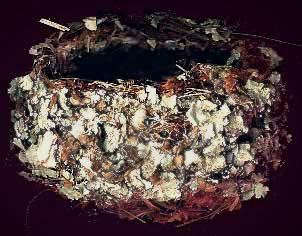 We all find bird nests from time to time and some of us even construct them at summer camp. The nest at the right was found one day well inside a soybean field in Kentucky, apparently blown there by a recent storm. The nest is 2.5 inches across (6.5 cm), covered on the outside with lichens, and most of the nest's body is composed of thin grass fibers, and what looks like spongy padding from a hunter's falling-apart chair left in the woods!
We all find bird nests from time to time and some of us even construct them at summer camp. The nest at the right was found one day well inside a soybean field in Kentucky, apparently blown there by a recent storm. The nest is 2.5 inches across (6.5 cm), covered on the outside with lichens, and most of the nest's body is composed of thin grass fibers, and what looks like spongy padding from a hunter's falling-apart chair left in the woods!
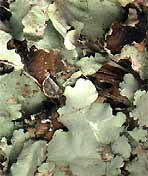 At the left you can see a close-up of some of the lichens covering the nest's outside. The lichens were put there by the bird building the nest. They help waterproof the nest and camouflage it. Holding the nest, two questions came to mind:
At the left you can see a close-up of some of the lichens covering the nest's outside. The lichens were put there by the bird building the nest. They help waterproof the nest and camouflage it. Holding the nest, two questions came to mind:
- What keeps the lichens stuck to the nest?
- Why does the nest feel so "spongy"
After a little poking at the nest, the answer became clear: spider webs.
 When a corner of the nest was pulled apart, you could see what's shown at the right. White, silky strands of spider web stretched across the tear. Most spider webs are sticky so that insects caught in them have a hard time escaping. In this case, the sticky spider webs were holding the bird nest together!
When a corner of the nest was pulled apart, you could see what's shown at the right. White, silky strands of spider web stretched across the tear. Most spider webs are sticky so that insects caught in them have a hard time escaping. In this case, the sticky spider webs were holding the bird nest together!
WHO BUILT THAT NEST?
Doing the detective work to find out which bird species built the nest was fun, and it's exactly the kind of fun you can have. It started by paying attention to these details:
SIZE: The size, 2.5 inches (6.5 cm) across is relatively small, so obviously it hadn't been built by anything like a hawk, crow, or even something as large as an American Robin or Mockingbird. A good first guess -- a first hypothesis -- was that it was a warbler's nest, for warblers are small birds and several warbler species were known to nest in the woods surrounding the cornfield.
FORM: Here are the main kinds of bird nests classified according to form:
- Scrapes -- shallow depressions scratched into the ground or leaves, such as the oystercatcher's
- Platform nests -- platforms built in tree tops or on shallow water, such as the Common Black Hawk's at the right
- Cup nests -- the most common type, built by most songbirds, shaped like a cup
- Adherent nests -- a kind of cup nest, typically mud, plastered to a building wall or stone ledge, like the Barn Swallow's at the right
- Pensile nests -- open cup nest suspended beneath the forks of a tree branch, not sitting on anything, as built by vireos
- Pendulous nests -- bag-like nests suspended from the tips of branches, as built by the Altamira Oriole at the right
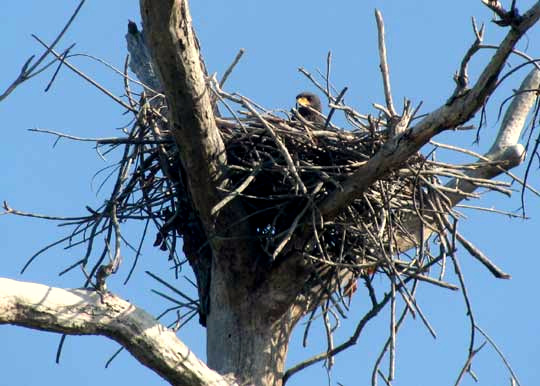
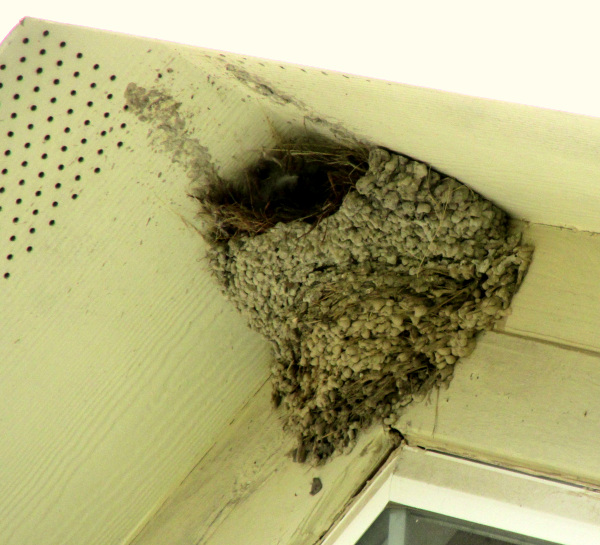
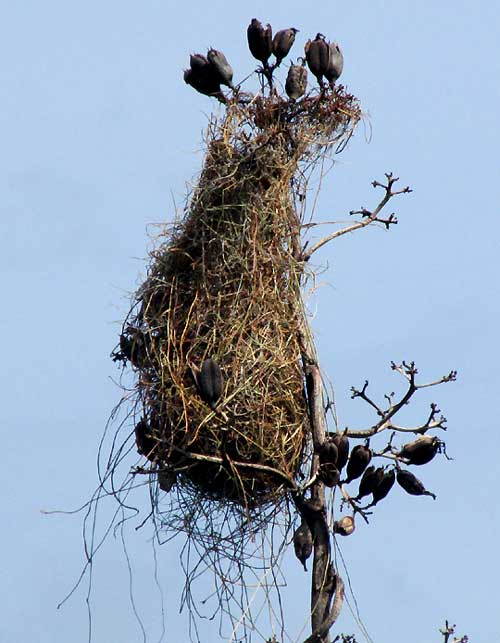
Our nest was shaped like a cup and from the fact that no lichens had been stuck to the nest's lower sides it was apparent that the nest probably had been built in the fork of a tree branch -- that it didn't dangle from anything. If that was true, then the nest hadn't been built by the small birds know as vireos, which also inhabited the woods around the field, because they build dangling "pensile nests." Here was more evidence supporting the hypothesis that the nest had been built by a warbler.
NEST COMPOSITION: The lichens covering the nest commonly grow on the bark of forest trees, so that was more evidence that the nest was a warbler's, because most of our warblers live in the forest. The fuzzy chair stuffing also supported this idea, because hunters sometimes leave old kitchen chairs in the woods to sit on as they wait for their squirrels or deer!
BY KNOWING WHAT SPECIES ARE PRESENT: Lots of warblers lived in the woods, but also other small bird species were there, so at this point in the detective work, the species list didn't help much.
INTERNET TO THE RESCUE!
At this point an image search for pictures of nests looking like our was made on the Internet. On Google's Advanced Image Search page, these words were typed into the search box: bird nest spiderweb lichen. That's not very grammatical, but search engines look for keywords, not good grammar.
Google did not come up with a warbler nest. It came up with several pages showing Ruby-crowned Kinglet nests, which may contain spiderwebs. However, in the eastern US, Ruby-crowned Kinglets don't nest as far south as Kentucky!
Nonetheless, mention of the Ruby-crowned Kinglet was important, for there is a small woodland bird in Kentucky who belongs to the same family as the kinglets, and that's the Blue-gray Gnatcatcher. And usually birds in the same family build rather similar nests.
Re-Googling our nest, this time specifically wanting to see a Blue-gray Gnatcatcher's nest, up came pictures of nests looking as much like ours as possible. Further Googling of pictures of warbler nests indicated that most warbler nests are not covered with lichens and aren't nearly as neat and roundish as our gnatcatcher nest.
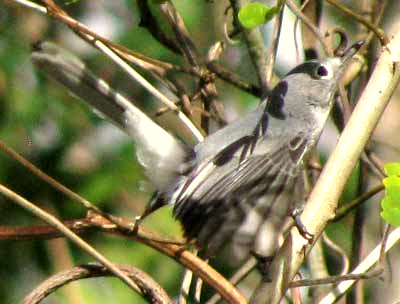
Therefore: Blue-gray Gnatcatcher! That's one at the right
So, the thing to remember when you want to identify a nest is, first, pay attention to the four characteristics outlined above and then use Internet image searches to confirm or reject your suspicion.
